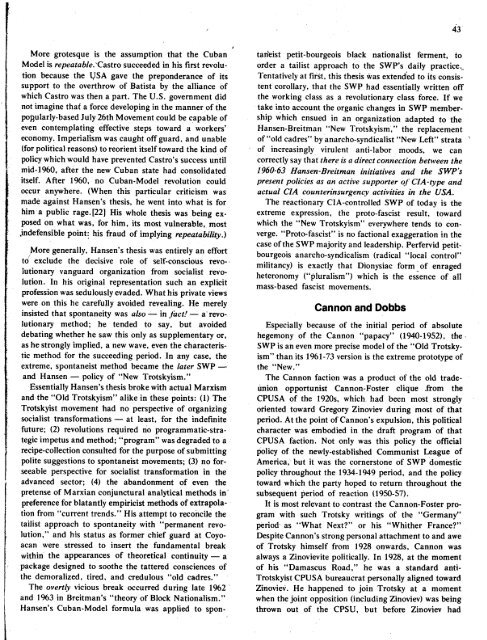S LIBERAL HELPERS
S LIBERAL HELPERS
S LIBERAL HELPERS
- No tags were found...
You also want an ePaper? Increase the reach of your titles
YUMPU automatically turns print PDFs into web optimized ePapers that Google loves.
More grotesque is the assumption that the Cuban tan'eist petit-bourgeois black nationalist ferment, toModel is repeatable.'Castro succeeded in his first revolu- order a tailist approach to the SWP's daily practice_.tion because the USA gave the preponderance of its Tentatively at first, this thesis _vas extendled to its consissupportto the overthrow of Batista by the alliance of tent corollary, that the SWP had essentially written offwhich Castro was then a part. The U.S. government did the working class as a revolutionary class force. If wenot imagine thaf a force developing in the manner of the take into account the organic changes in SWP memberpopularly-basedJuly 26th Movement could be capable of ship Which ensued in an organization adapted to theeven Contemplating effective steps toward a workers' Hansen-Breitman "New Trotskyism," the replacementeconomy. Imperialism was caught off guard, and unable of"old cadres" by anarcho-syndicalist "New Left" strata(for political reasons) toreorient itself toward the kind of of increasingly virulent anti-labor moods, we canpolicy which would have prevented Castro's success until correctly say that there is a direct connection between theraid-1960, after the new Cuban state had consolidated 1960-63 Hansen-Breitman initiatives and the SWP'sitself. After 1960, no Cuban-Model revolution could present policies as an active supporter o.f CIA-type andoccur anywhere. (When this particular criticism was actual CIA counterinsurgency activities in the USA.made against Hansen's thesis, he went into what is for The reactionary CIA-controlled SWP of today is thehima public rage.[22] His whole thesis was being ex- extreme expression, the proto-fascist result, towardposed on what was, for him, its most vulnerable, most which the "New Trotskyism" everywhere tends to con-,indefensible point_ his fraud of implying repeatability.) verge. "Proto-fascist" is no factional exaggeration in thecase of the SWP majority and leadership. Perfervid petit-More generally, Hansen's thesis was entirely an effort bourgeois anarcho-syndicalism (radical "local control"to/ exclude the decisive role of self-conscious revo-- militancy) is exactly that Dionysiac form of enragedlutionary vanguard organization from socialist revo- heteronomy ("pluralism") which is the essence of alllution. In his origina! representation such an explicit mass-based fascist movements.profession was sedulously evaded. What his private viewswere on this he carefully avoided revealing. He merely Cannotl and Dobbsinsisted that spontaneity was al_o in .fact!- a' revolutionarymethod; he tended to say, but avoided Especially because of the initial period of absolutedebating whether he saw this only as supplementary or, hegemony of the Cannon "papacy" (1940-1952), the •as he strongly implied, a new wave, even the characteris- SWP is an even more precise model of the "Old Trotskyticmethod for the succeeding period. In any case, the ism" than its 1961-73 version is the extreme prototype ofextreme, spontaneist method became the later SWP the "New."and Hansen -- policy of "New Trotskyism." The Cannon faction was a product of the old trade-Essentially Hansen'sthesisbrokewithactualMarxism union opportunist Cannon-Foster clique _om theand the "Old Trotskyism" alike in these points: (1) The CPUSA of the 1920s, which, had been most stronglyTrotskyist movement had no perspective of organizing oriented toward Gregory Zinoviev during most of thatsocialist transformations at least, for the indefinite period. At the point of Cannon's expulsion, this politicalfuture; (2) revolutions required no programmatic-stra- character was embodied in the draft program of thattegic impetus and method; "program" was degraded toa CPUSA faction. Not only was this policy the officialrecipe-collection consulted for the purpose of submitting policy of the newly-established Communist League ofpolite suggestions to spontaneist movements; (3) no for- America, but it was the cornerstone of SWP domesticseeable perspective for socialist transformation in the policy throughout the 1934-1949 period, and the policyadvanced sector; (4) the abandonment of even the toward which the party hoped to return throughout thepretense of Marxian conjunctural analytical methods in subsequent period of reaction (1950-57).preference for blatantly empiricist methods of extrapola- It is most relevant to contrast the Cannon-Foster protionfrom "current trends." His attempt to reconcile the gram with such Trotsky writings of the "Germany"tailist approach to spontaneity with "permanent revo- period' as "What Next?" or his "Whither France?"lution," and his status as former chief guard at Coyo- Despite Cannon's strong personal attachment to and aweacan were stressed to insert the fundamental break of Trotsky himself from 1928 onwards, Cannon waswithin the appearances of theoretical continuity m a always a Zinovievite politically. In 1928, at the momentpackage designed to soothe the tattered consciences of of his "Damascus Road," he was a standard antithedemoralized, tired, and credulous "old cadres." Trotskyist CPUSA bureaucrat personally aligned towardThe overtly vicious break occurred during late 1962 Zinovie,_. He happened to join Trotsky at a momentand 1963 in Breitman's "theory of Block Nationalism." when the joint opposition (including Zinoviev) was beingHansen's Cuban-Model formula was applied to spon- thrown out of the CPSU, but before Zinoviev had

















